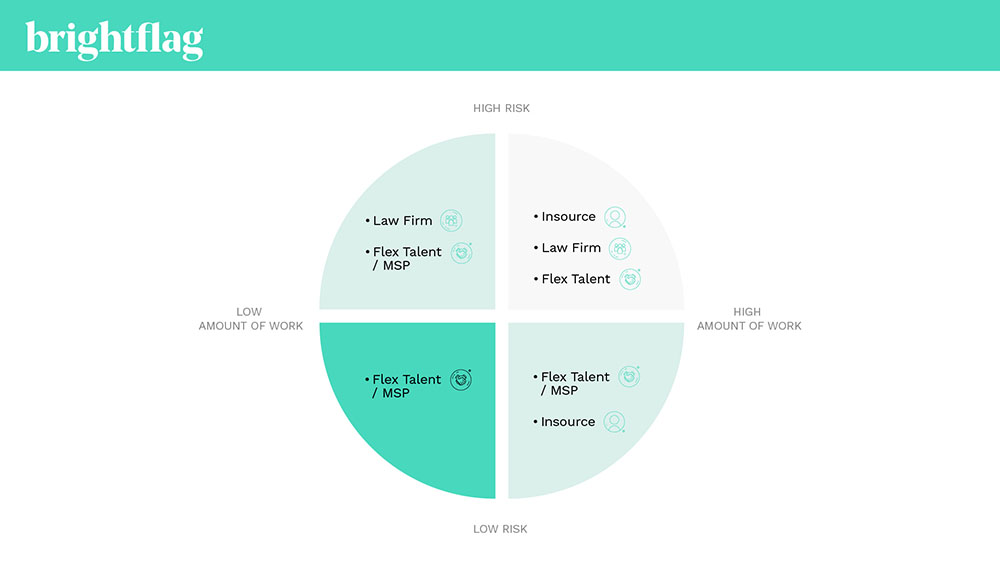What is Rightsourcing, and How Can You Apply Its Benefits to Your Legal Team?
The Rise of Rightsourcing
Have you seen the recent release of the ACC’s 2023 CLO Survey? To my surprise (and delight), the CLO’s second-highest strategic priority for the legal department is rightsourcing legal services—which was listed by 45% of those surveyed.
This was surprising mainly because I had never seen the term “rightsource” in any survey, text, or article prior to this report’s release.
Furthermore, when I surveyed my network—admittedly, a much smaller survey pool, but large enough to be directional—60% had never even heard the term.
As the President & COO of Paragon Legal, the leading company for interim legal talent for in-house legal departments, we’ve been helping clients of all different sizes solve this rightsourcing issue since 2006. And with so many legal departments feeling cost pressures like never before (feel free to check out why I think that is here), rightsourcing is one of the highest value tools there is. No wonder that CLOs have it as one of their top strategic priorities this year.
What is Rightsourcing?
In the simplest terms, rightsourcing is matching the work that needs to be done to the right resource. That could include insourcing, outsourcing to a law firm, or outsourcing to an ALSP. The goal is to meet the needs of the business and legal department in the most efficient, cost-effective way.
A bonus feature of rightsourcing legal services is that it helps make sure your in-house team is not burnt out, and that they are working on the matters that are the highest priority and best use of their time. So it’s a retention tool as well—and can protect you from the costs of high attrition that I outlined here.
How Do You Get Started?
Great question—so glad I asked. Below I’ve outlined a very tactical way to get you started.
Like any other strategic initiative, start by laying out the objectives:
- What do you need to achieve for the business?
- What do you need to achieve for the legal department? (Hopefully 1 and 2 are aligned, and can be
resolved if not) - What is the dollar-savings or value-created goal you’re targeting with this initiative? (There are real dollars here, so aim high!)
Next, lay out all of the options. How can the work get done?
1) Outsourcing
- Law firm
- Flex talent company (a la Paragon Legal)
- Managed service provider
- And more!
2) Insourcing
- Specialized attorney / generalist attorney
- Legal operations professional
- Contracts manager / project managers / paralegal / and more!
After thinking through the objectives and laying out all of the options, the third step would be to set up a matrix to think through who should do what. The two variables that I like to think through are risk and the amount of work.
A word of caution on “amount of work”: make sure to consider it not only on a weekly/monthly basis, but also based on the length of need. For example, if you need full-time support, but for only 1–2 years, insourcing may not be the best option as it could have a negative impact on morale and culture—and therefore retention.
The matrix could look something like this:

Within each type of matter, you can assess:
- Do I need someone fully embedded on the team? If yes, insource or use flex talent. Do I have
headcount? If no, use flex talent - Is this a bet-the-company matter? If yes, use a law firm
- Is this day-to-day low risk work? If yes, then do not use a law firm
It is super helpful if you have a spend management tool, like Brightflag, to understand how much you spend outsourcing on each matter. This is the easiest place to start, and can help you compare who is working on each matter to your matrix and analysis.
You could do this manually too, but spend management tools make it a lot faster. And if it doesn’t match, start thinking about how to get in alignment. Then do the math (my favorite part!) to compare options to get back in alignment with your analysis.
Focusing on Your In-House Team
Your in-house team’s time doesn’t go through a platform like Brightflag, so how can you make sure your team is working on the right stuff? Well, ask them.
This is where having a high-trust culture is important such that you can ask your team to track how they spend their time. See if they can document their work for a month or a quarter (depending on the role and the ebbs and flows of the work), so you can understand how everyone is spending their time. No, this does not need to be in 6-minute increments— the goal is simply to be directionally correct so that you can make smart decisions.
High-trust cultures and transparency here are of the utmost importance. If this is something you have never asked your team to do before, it can cause some angst and discomfort. But the goal is to understand capacity and make sure everyone is spending their time on the highest priority, most important matters.
Conclusion
Demands on in-house legal departments are ever-expanding, and taking the time to think through the best way to get the work done is critical. Rightsourcing legal services is one of the key tools in your toolkit.
If you have any questions about getting started or building on the strategy you already have in place, feel free to message me on Linkedin!
Please note: Guest blog articles featured on our platform reflect the opinions of the authors themselves and not necessarily those of Brightflag. We value diversity of thought and appreciate our writers’ unique perspectives, which we hope will stimulate meaningful discussions in our community.



